scarf post - c’est la fête
I'm finally going to make good on my threat to start making scarf posts.
No. 1 is a design near and dear to my heart, and a bit of a grail in the scarfies community. It has only ever been issued as a men's 70cm, so all the colourways are quite subdued and not particularly to my taste. Normally that's a deal-breaker for me, but the design won out and I ended up with a colourway that doesn't really suit me, so now I can't decide whether to start wearing it or to leave it in mint condition for a possible future sale. It's the only scarf in my collection that I don't wear. Maybe I'll get it framed eventually.
C’est La Fête by Daisuke Nomura, 2012
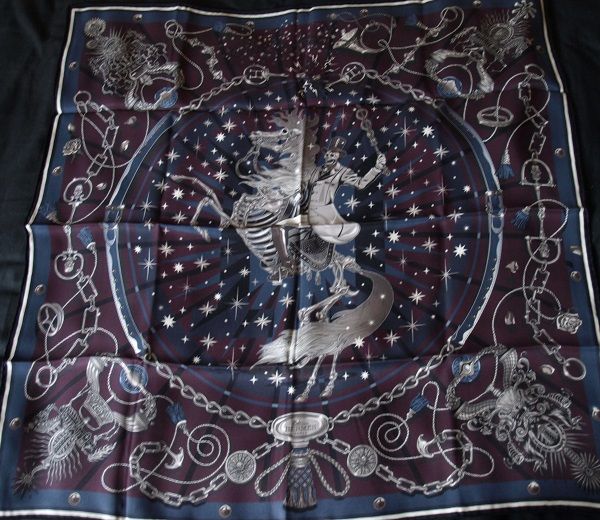
I spent quite a lot of time contemplating this design while making No Church in the Wild, which of course had a similar leitmotif. But the main thing to take away from this design is that it's not about mourning death as much as it is about celebration - the design was issued to celebrate the life of a Dumas family member. (H is majority family-owned by Dumas - something that came to a lot of media attention recently when LVMH tried to underhandedly hijack the company.)
Instead of trying to do my own clumsy write-up, I'm going to copy/paste excerpts from this interesting write-up from TPF. Can't say to whether it's the right or only explanation, and I don't particularly want to interpret in light of any specific religion, but I like how deeply it digs.
**
"First things first: Horsey! That’s to say, the scarf is utterly traditional in that it depicts 5 horses and many items to be used for horse riding, such as leather harness, horseshoes, etc. This is important because the first thing we see are the skeletons and we might think it is outrageous for Hermès to do this... So rest assured, buying this scarf will get you a very traditional carré.
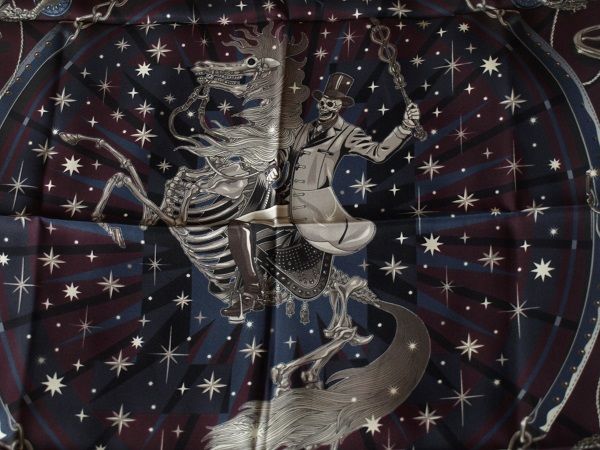
Now onto the real thing. Let us start with the middle part. The basis is the well-known circle with H. On top of this we see a horse and horseman, but both as skeletons. This invokes very traditional symbolism of Western mysticism and gnosticism. Perhaps it is easiest explained as depicting the Tarot card of Death. In the card game of Tarot, the card of Death is exactly a skeleton horseman. Rest assured, it does not mean death. Instead, death is itself a symbol. Some frequent keywords used by tarot readers for the interpretation of Death are:
- Ending of a cycle--Loss--Conclusion--Sadness
- Transition into a new state--Psychological transformation
- Finishing up--Regeneration--Elimination of old patterns
- Being caught in the inescapable--Good-byes--Deep change
So instead what we see here is that the scarf reminds us that the theme of this year The Gift of Time is something we are given but just as easily it is taken from us. As time passes things undeniably change and it is our task to deal with those changes. E.g. at some point we stop being adolescents and need to accept we are adults. When we become parents our life alters dramatically. And so on.
In Tarot, the card of Death holds a banner with a flower and here the horseman does not hold a flag. We do notice roses in the top-left and bottom-right corner and again we may note that a rose is a traditional symbol for death and the withering of life. We grow, we blossom, and eventually we wither.
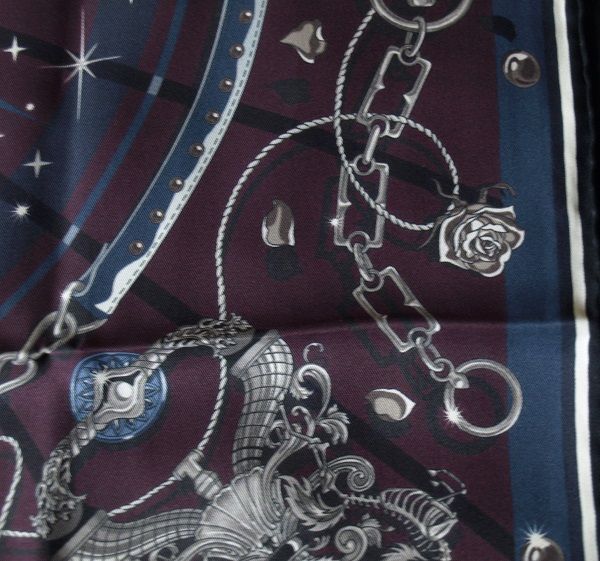
The scarf goes much farther beyond this, though. Instead of the flag, the horseman is holding a staff with two snakes. This is none other than the staff of Hermes (the Greek god). Hermès-the-company took its name from its founder, but it has repeatedly shown respect to the many mythological and mystical stories around Hermes-the-historical-(and/or mythological)-figure. E.g. the two-snake staff also appears sometimes on their logo, e.g. when you order something online the accompanying letter shows this. Another example is that the Greek god Hermes was known by the Romans as Mercury and so the scarf Vif Argent may be seen as a pun on this.
Because of the staff, we now know that the horseman is supposed to be Hermes. He was one of twelve great Gods of the Greeks who was the gods’ herald and messenger. That means, he was the one in charge to travel in between the divine world and the earthly world. As such, he brought messages from above to human beings in this world, but more important was his task of guide/escort of the dead to their new dwelling. In Greek mythology this meant that Hermes guided the dead down to Hades, the netherworld. But the name Hermes is also applied to the Egyptian mystic figure Thoth. The Egyptian Hermes imparts two kinds of knowledge in his books. First, it is possible to gain a degree of power in and control over the terrestrial world through a knowledge of the harmony of the stars and planets. Thus Hermes teaches, for example, the interpretation of heavenly signs for the future, as well as the occult properties of substances, such as different plants, and the astral powers they possess. Second, and more famously, Hermes teaches his disciples how to transcend their bodily circumstances and to overcome destiny through purification of the intellect and contemplation, leading to a true knowledge of God.
Thus, through the centuries under influence of the great religions such Christianity and Islam, and more importantly due to mystical philosophy of Neoplatonism, Hermes would no longer lead people down, but up. After shedding our material self, our flesh, we would enter the Divine World itself, to become like Angels. Our body may go corrupt, but our eternal soul, made of immaterial light, would live on forever. This is indicated by the figures being skeletons, as the flesh has already decayed, gone corrupt, and has no use anymore. Hermes and his horse show their naked selves in an act of provocation; your body will do you no good anymore beyond this point. The jacket and top hat may be used to further press this point of provocation; he looks rather silly with his top hat doesn't he? To him it is all a joke, all those nice clothes you have bought over your lifetime, it doesn't matter to him (it does to Hermes-the-company ;) ). In a way, he is both mocking life and death, but perhaps mostly death since it is associated with our earthly lives while life will get a new definition in the World of Lights.
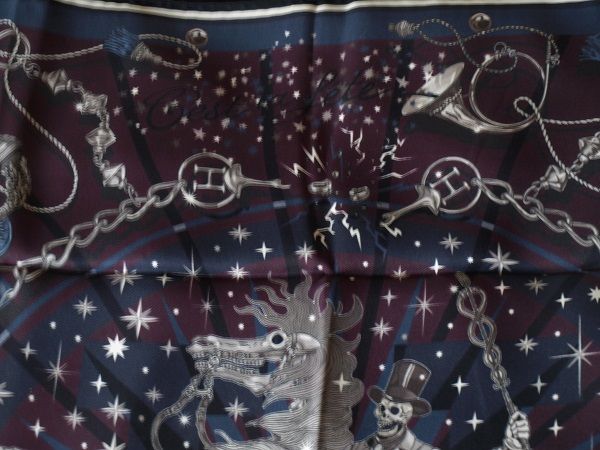
All around the scarf we see shackles and chains. They represent two things. First, they symbolize the chain of life, of which we all are part. Second, they symbolize that our luminous souls are chained to this world and imprisoned in our bodies...
This is most boldly displayed by the chain going around the center, which at the top is very visibly broken. The sparkles coming off the broken chain shows this is a major event. The Horn above it is actually a symbol of the Last Day (Day of Judgment) but here perhaps it merely indicates our escape from the material world. The title itself, “C’est la fête” could also be a pointer to the greatness of the event of our death; our death is something to celebrate, one of the best thing that will happen to you!"
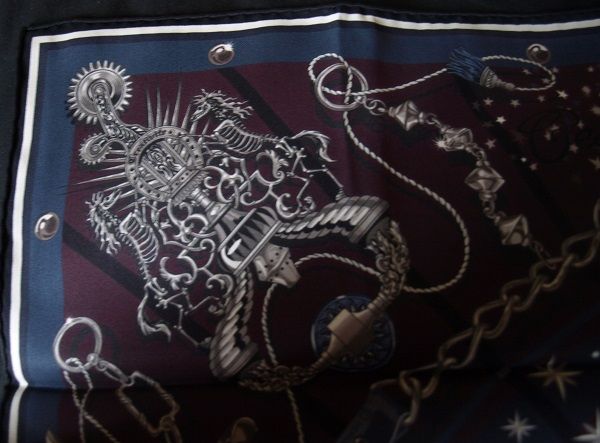
No. 1 is a design near and dear to my heart, and a bit of a grail in the scarfies community. It has only ever been issued as a men's 70cm, so all the colourways are quite subdued and not particularly to my taste. Normally that's a deal-breaker for me, but the design won out and I ended up with a colourway that doesn't really suit me, so now I can't decide whether to start wearing it or to leave it in mint condition for a possible future sale. It's the only scarf in my collection that I don't wear. Maybe I'll get it framed eventually.
C’est La Fête by Daisuke Nomura, 2012

I spent quite a lot of time contemplating this design while making No Church in the Wild, which of course had a similar leitmotif. But the main thing to take away from this design is that it's not about mourning death as much as it is about celebration - the design was issued to celebrate the life of a Dumas family member. (H is majority family-owned by Dumas - something that came to a lot of media attention recently when LVMH tried to underhandedly hijack the company.)
Instead of trying to do my own clumsy write-up, I'm going to copy/paste excerpts from this interesting write-up from TPF. Can't say to whether it's the right or only explanation, and I don't particularly want to interpret in light of any specific religion, but I like how deeply it digs.
**
"First things first: Horsey! That’s to say, the scarf is utterly traditional in that it depicts 5 horses and many items to be used for horse riding, such as leather harness, horseshoes, etc. This is important because the first thing we see are the skeletons and we might think it is outrageous for Hermès to do this... So rest assured, buying this scarf will get you a very traditional carré.

Now onto the real thing. Let us start with the middle part. The basis is the well-known circle with H. On top of this we see a horse and horseman, but both as skeletons. This invokes very traditional symbolism of Western mysticism and gnosticism. Perhaps it is easiest explained as depicting the Tarot card of Death. In the card game of Tarot, the card of Death is exactly a skeleton horseman. Rest assured, it does not mean death. Instead, death is itself a symbol. Some frequent keywords used by tarot readers for the interpretation of Death are:
- Ending of a cycle--Loss--Conclusion--Sadness
- Transition into a new state--Psychological transformation
- Finishing up--Regeneration--Elimination of old patterns
- Being caught in the inescapable--Good-byes--Deep change
So instead what we see here is that the scarf reminds us that the theme of this year The Gift of Time is something we are given but just as easily it is taken from us. As time passes things undeniably change and it is our task to deal with those changes. E.g. at some point we stop being adolescents and need to accept we are adults. When we become parents our life alters dramatically. And so on.
In Tarot, the card of Death holds a banner with a flower and here the horseman does not hold a flag. We do notice roses in the top-left and bottom-right corner and again we may note that a rose is a traditional symbol for death and the withering of life. We grow, we blossom, and eventually we wither.

The scarf goes much farther beyond this, though. Instead of the flag, the horseman is holding a staff with two snakes. This is none other than the staff of Hermes (the Greek god). Hermès-the-company took its name from its founder, but it has repeatedly shown respect to the many mythological and mystical stories around Hermes-the-historical-(and/or mythological)-figure. E.g. the two-snake staff also appears sometimes on their logo, e.g. when you order something online the accompanying letter shows this. Another example is that the Greek god Hermes was known by the Romans as Mercury and so the scarf Vif Argent may be seen as a pun on this.
Because of the staff, we now know that the horseman is supposed to be Hermes. He was one of twelve great Gods of the Greeks who was the gods’ herald and messenger. That means, he was the one in charge to travel in between the divine world and the earthly world. As such, he brought messages from above to human beings in this world, but more important was his task of guide/escort of the dead to their new dwelling. In Greek mythology this meant that Hermes guided the dead down to Hades, the netherworld. But the name Hermes is also applied to the Egyptian mystic figure Thoth. The Egyptian Hermes imparts two kinds of knowledge in his books. First, it is possible to gain a degree of power in and control over the terrestrial world through a knowledge of the harmony of the stars and planets. Thus Hermes teaches, for example, the interpretation of heavenly signs for the future, as well as the occult properties of substances, such as different plants, and the astral powers they possess. Second, and more famously, Hermes teaches his disciples how to transcend their bodily circumstances and to overcome destiny through purification of the intellect and contemplation, leading to a true knowledge of God.
Thus, through the centuries under influence of the great religions such Christianity and Islam, and more importantly due to mystical philosophy of Neoplatonism, Hermes would no longer lead people down, but up. After shedding our material self, our flesh, we would enter the Divine World itself, to become like Angels. Our body may go corrupt, but our eternal soul, made of immaterial light, would live on forever. This is indicated by the figures being skeletons, as the flesh has already decayed, gone corrupt, and has no use anymore. Hermes and his horse show their naked selves in an act of provocation; your body will do you no good anymore beyond this point. The jacket and top hat may be used to further press this point of provocation; he looks rather silly with his top hat doesn't he? To him it is all a joke, all those nice clothes you have bought over your lifetime, it doesn't matter to him (it does to Hermes-the-company ;) ). In a way, he is both mocking life and death, but perhaps mostly death since it is associated with our earthly lives while life will get a new definition in the World of Lights.

All around the scarf we see shackles and chains. They represent two things. First, they symbolize the chain of life, of which we all are part. Second, they symbolize that our luminous souls are chained to this world and imprisoned in our bodies...
This is most boldly displayed by the chain going around the center, which at the top is very visibly broken. The sparkles coming off the broken chain shows this is a major event. The Horn above it is actually a symbol of the Last Day (Day of Judgment) but here perhaps it merely indicates our escape from the material world. The title itself, “C’est la fête” could also be a pointer to the greatness of the event of our death; our death is something to celebrate, one of the best thing that will happen to you!"
